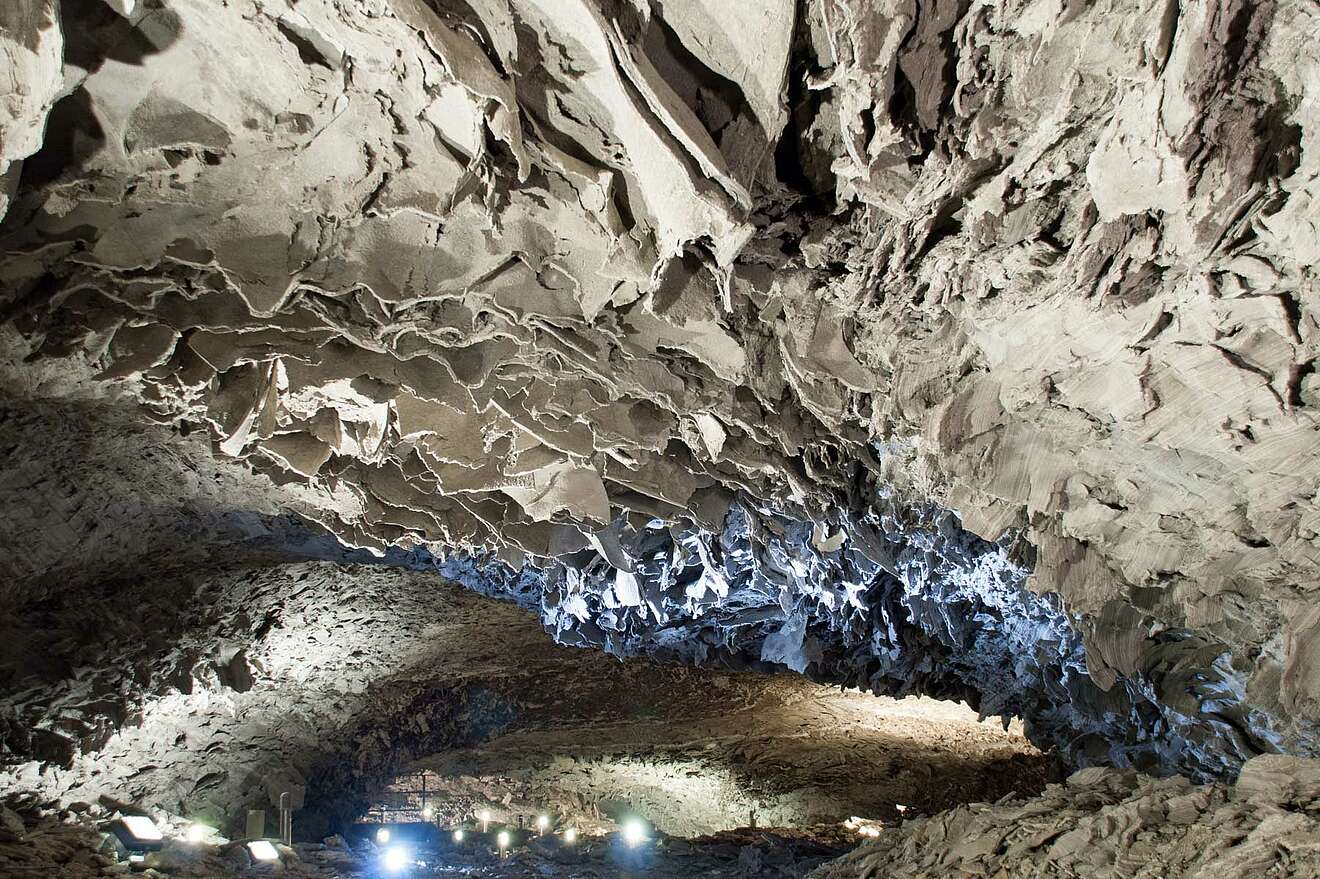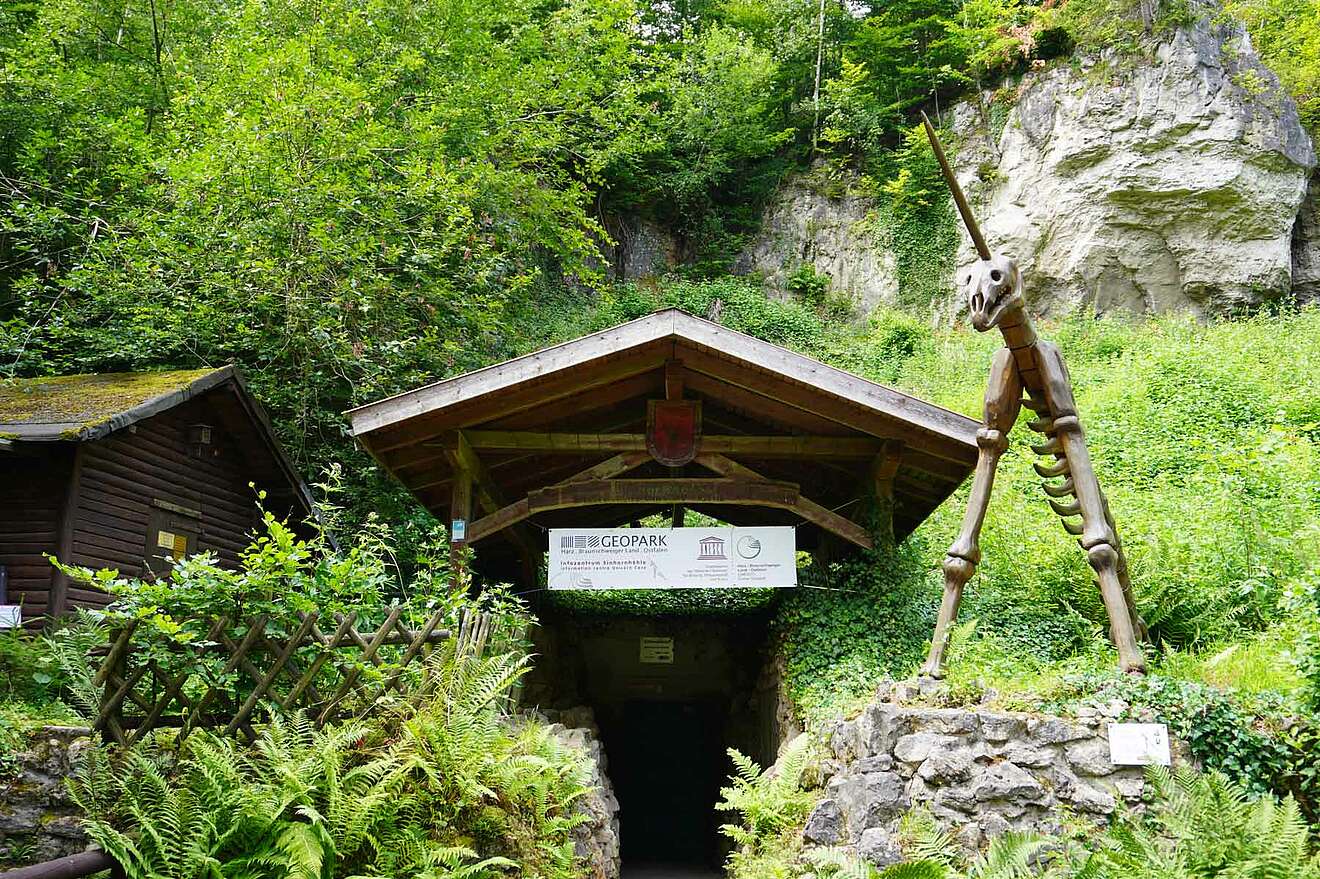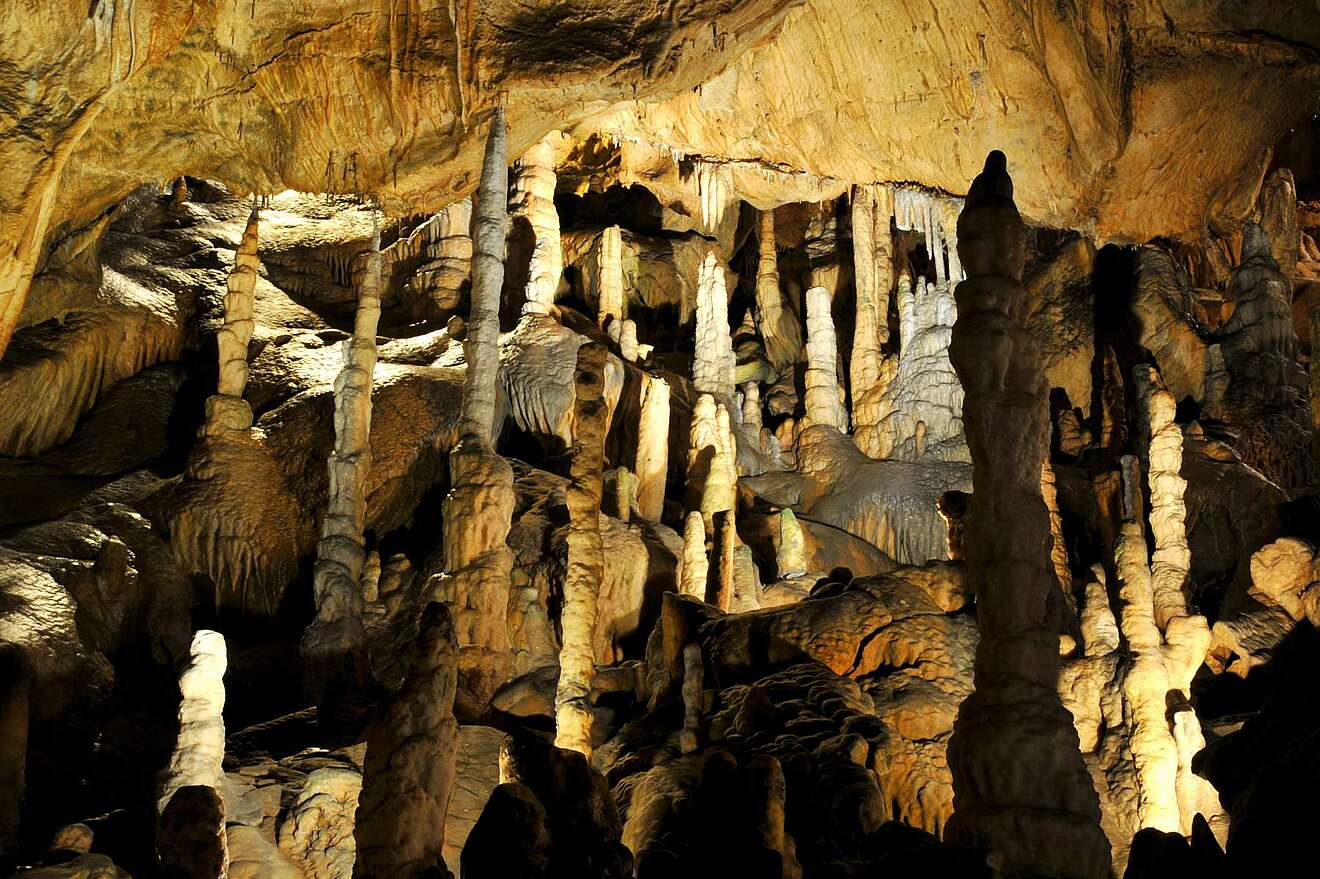
Caves in the Harz Mountains
All over the world, caves are considered to be particularly mystical, fascinating and exciting, which is why they are always a favourite destination for many a trip. In the Harz Mountains in particular, which are known to many for their majestic mountain scenery and the dense forests of the national park, there are numerous caves waiting to be discovered underground. If you only see the obvious above ground in the Harz Mountains, you may miss out on some breathtaking cave worlds beneath your own soles, which not only offer insights into the geological history, but also into the mining history of the region. Underground, a completely mystical and wondrous world opens up, which centuries ago exerted an unrivalled attraction on adventurers and explorers. Dark and sometimes brightly lit passages in show caves, underground lakes and glittering crystal formations await you.
Even though each of the Harz caves is individual and unique in its history, their origins are usually more similar than you might think. The majority of them were formed over a very long period of time by the action of water or were discovered by miners who were once digging for precious ores. Another common feature of the cave systems in the Harz Mountains is their temperature, which remains fairly constant throughout the year at around 8 degrees Celsius, which should certainly come in handy for hikers on hot summer days. While some of the caves in the Harz Mountains are open to visitors and are a popular destination for tourists and holidaymakers, others remain closed and guard their unexplored secrets. You can find out which caves in the Harz Mountains are open and which are not in our tabular overview at the end of the article. In the following, however, we first present the top 6 caves in the Harz Mountains that you should definitely not miss.
1st Iberg Dripstone Cave and Cave Experience Centre
The cave's impressive rock and stalactite formations fascinate visitors with their unusual shapes and colours and cast a spell over nature lovers and history buffs alike. Children in particular are enchanted by the fairytale kingdom deep underground and listen spellbound to the stories about the dwarf king Hübich, who, according to legend, lived deep in the Iberg. The Iberg stalactite cave can be visited as part of regular guided tours, which provide an exciting insight into the underground world. Geocaching fans will also get their money's worth here, as there is an earth cache inside the cave.
The Cave Experience Centre complements the visit to the dripstone cave with interactive exhibitions that use multimedia to bring the formation of the cave and Harz cave research to life. A special highlight is the replica of the over 3000-year-old tomb of the Bronze Age family from the neighbouring Lichtenstein Cave. Archaeological finds, including well-preserved bones, have made it possible to decode the DNA of 62 family members and prove that they were related up to the present day. The exhibition impressively shows the reconstruction of this ancient family tree and brings the history of the cave dwellers back to life with the help of modern film technology.
2. barbarossa cave
Located in the Kyffhäuser Nature Park, around 6 kilometres from the brine spa town of Bad Frankenhausen, the Barbarossa Cave offers an extraordinary natural experience. Covering an impressive 15,000 square metres, visitors can immerse themselves in the geological history of the region on an exciting adventure and learn more about Emperor Frederick I Barbarossa and the famous legend that gave the cave its name. The Barbarossa Cave is a geological rarity, as it is one of only two show caves in anhydrite rock in the world. It was discovered by chance on 20 December 1865 by miners looking for copper. Just a few weeks after its discovery, the cave was opened to visitors and has enjoyed great popularity ever since.
The Barbarossa Cave is characterised by its huge cavities, which are characterised by crystal-clear, shimmering blue-green lakes and impressive ceiling reflections. Fascinating rock structures such as alabaster, snake plaster and the so-called plaster lobes make the cave a unique natural wonder. The curved plaster lobes, which hang from the ceilings and are reminiscent of drying hides or skins, are created by the transformation of anhydrite into gypsum, which gains volume in the process.
A particular highlight of the cave is the dance hall where, according to legend, Emperor Barbarossa resided sitting at a marble table. Legend has it that he sleeps in an underground castle and will only awaken again when Germany is united. Guided tours of the Barbarossa Cave take visitors through this impressive underworld over a distance of around 800 metres in around an hour. As with many Harz caves, the temperature here is a constant 9 degrees Celsius all year round, making the cave a particularly attractive destination on hot summer days.

3. unicorn cave
The legendary Unicorn Cave, located in the western Harz Mountains between Bad Lauterberg and Herzberg near Scharzfeld, is one of the largest and most fascinating karst caves in the region. It is located in the natural cavities of the so-called "Harz Dolomites" and consists of Permian Zechstein dolomite, which was formed around 270 million years ago. This rock weathered over thousands of years, forming the impressive cave systems of the Unicorn Cave. With a total length of more than 700 metres, 300 metres of which are accessible, it is one of the largest caves in the Harz Mountains. There are several halls and domes along the main route, which are connected by smaller passages. The only natural entrances to the cave are in the south-west at the Blue Grotto, which has two openings in the ceiling. Since 1905, however, an artificial tunnel leading into the White Hall has served as the main entrance.
The cave owes its name to an old myth that captivated many people as early as the 17th century. It was believed that the bones of unicorns could be found here, whose remains, ground into powder, were coveted throughout Europe as a remedy. In fact, however, they were fossils of cave bears and other large mammals, as was finally discovered in the 17th century. The Unicorn Cave also attracted prominent researchers and personalities such as Johann Wolfgang von Goethe (1784), Gottfried Wilhelm Leibniz (1686), Hermann Löns and the anatomist Rudolf Virchow.
The cave is not only a place steeped in legend, but also an important natural and cultural monument. Excavations in 1985 and 1988 showed that it was inhabited by Neanderthals over 100,000 years ago. Modern research also suggests that the Unicorn Cave is only a small part of a much larger underground system. The currently accessible area could merely be the "attic" of an as yet unexplored cave system below, which adds to its fascination.

4th Hermann's Cave
The Hermannshöhle, like the Baumannshöhle, is part of the Rübeländer stalactite caves and is particularly famous for the Olmensee, home to Germany's only olms. These extraordinary animals, which are normally only found in caves in south-east Europe, are perfectly adapted to life in complete darkness. With their pigmentless skin and rudimentary eyesight, they look like creatures from another world and symbolise the mysterious world of Hermann's Cave. In addition to the olms, 17 species of bat have also found ideal retreats in the cave, as the sheltered, dark areas offer ideal living conditions.
Hermann's Cave was discovered by chance in the 19th century during road construction work and quickly developed into an attraction. Its impressive formations and sheer size aroused the interest of scientists and visitors alike. The accessible area leads deep underground and reveals a fascinating world of stalactites and unique geological structures. Visitors can admire impressive stalactites, stalagmites and limestone formations that make the cave a highlight in the Harz Mountains.
Hermann's Cave is part of the karst system in the Harz Mountains, which was formed over millions of years by the dissolution of limestone by water. This geological phenomenon created the underground cavities, stalactites and spectacular rock formations that can be seen today. The Devonian limestone typical of the Harz Mountains provided the perfect basis for the formation of these geological masterpieces. Exciting guided tours through the cave not only explain the history of its formation, but also allow visitors to experience the impressive dimensions and beauty of these natural processes.

5th Baumanshöhle
The Baumannshöhle is considered to be the oldest show cave in Germany and was discovered in 1536 by miner Friedrich Baumann, who gave the cave its name. According to legend, Baumann came across the cave by chance while searching for ore deposits. After his miner's light went out, he wandered around in the dark for three days before finding the exit. Although he still managed to report his discovery, he died a few days later as a result of his ordeal.
Baumann's Cave is located near Rübeland, close to the Bode Valley, and is surrounded by dense forests. Together with Hermann's Cave, it forms the Rübeland Dripstone Caves. The Baumannshöhle is characterised by the famous Goethesaal, named after its most famous visitor, Johann Wolfgang von Goethe. Goethe visited the cave several times, including in 1777, 1783 and 1784, and today the 300 square metre cave serves as a unique natural stage with space for up to 300 people. Illuminated stalactites create an impressive backdrop for theatre and music performances.
The Goethesaal also houses two stages and the artificial Wolfgangsee lake. The lake has a water temperature of around 8 degrees Celsius and a shallow depth of just 0.8 metres, making it another highlight of this fascinating stalactite cave. The Baumannshöhle combines history, nature and culture in an impressive way and remains an unforgettable experience for visitors of all ages.

6. show cave Heimkehle
The Heimkehle show cave is one of the two largest accessible gypsum caves in Germany and impresses with its underground lakes and the impressive 22-metre-high hall, the so-called dome. It is one of over 200 known caves in the sulphate karst in the southern Harz region and was first mentioned in a document in 1357. However, it was not opened up to tourists until 1920 by Theodor Wienrich, who made the cave accessible to visitors. In September of the same year, the Heimkehle was opened as the Harz Karst show cave and quickly developed into a popular attraction that has lost none of its fascination even today, over 100 years later.
The cave was formed by the erosion of the sulphate karst by the Thyra, Krebsbach and Krummschlacht rivers over several thousand years. Its shape is unusual: the ceiling forms a broad horizontal surface, while the accessible floor is much narrower, causing the walls to rise at an angle of around 45 degrees and creating a trapezoidal profile. With a total length of 2 kilometres, the Heimkehle is one of the larger caves in the region, although only 600 metres are accessible to visitors. The show cave has been designated a "National Geotope" and offers fascinating insights into the geological development of the region.
In addition to its function as a natural attraction, the Heimkehle also serves as a memorial. During the Second World War, the show cave was closed and from 12 March 1944, a protected factory was set up in the cave for the production of undercarriage parts, which were primarily needed for the JU88 aircraft produced by Junkerswerke Dessau. Over 1,500 prisoners from the Dora subcamp were forced to produce these parts under inhumane conditions. After the end of the war, the entrances to the cave and the armaments buildings were blown up. It was not until 25 April 1954 that the cave was reopened to the public.
A visit to the Heimkehle is only possible as part of a guided tour, which starts at the visitor centre. The route leads along the mountain of rubble through the giant tunnel into the Thyrahalle with Lake Thyra. Due to the constant cave temperature of around 8 degrees Celsius, visitors should not do without warm clothing. The Heimkehle is not only a geological highlight, but also a place of remembrance that combines nature and history in an impressive way.

Complete overview of all caves in the Harz Mountains
In the following table we offer you an overview of all caves in the Harz Mountains together with information on whether they can or may be entered or not.
| cave | to visit | Place | type | Length | Discovery |
|---|---|---|---|---|---|
| Barbarossa Cave | Yes | Rottleben / Kyffhäuserland | Anhydrite | 1.100m | 1865 |
| Baumann's cave | Yes | Rübeland | Stalactite cave | 1.980m | 1536 |
| Bielshöhle cave | No | Rübeland | Stalactite cave | - | 1672 |
| Bear Cave | No | Goslar | Mine entrance | - | 18XX |
| Daneil's Cave | Yes | Dingelstedt / Huy | Ice Age coloured sandstone | ~ 20m | - |
| Unicorn cave | Yes | Scharzfeld / Herzberg | Dolomite cave | 610m | 1541 |
| Forester's cave | Yes | Urbach / Nordhausen | Anhydrite | 75m | - |
| Heimkehle | Yes | Uftrungen / Southern Harz | Gypsum cave | 2.000m | 1357 |
| Hermann's Cave | Yes | Rübeland | Stalactite cave | 2.733m | 1866 |
| Himmelreich Cave | No | Walkenried | Anhydrite | 170m | 1868 |
| Cave dwellings | Yes | Langenstein / Halberstadt | carved by hand into the rock | - | 1787 |
| Iberg stalactite cave | Yes | Bad Grund | Stalactite cave | 351m | 1723 |
| Hedgehog swamp cave | No | Nordhausen | Eroded karst cave - danger of collapse | - | - |
| Jetten Cave | No | Düna / Osterode | Sulphate cave | 750m | 1308 |
| Karst cave Kelle | No | Ellrich | Anhydrite | 20m | - |
| Lessing cave | No | Bad Suderode / Quedlinburg | Ore mine | - | 15XX |
| Lichtenstein Cave | No | Osterode | Spring cave in gypsum karst | 135m | 1972 |
| Martha Cave | No | Düna / Osterode | Sulphate cave | 450m | 1924 |
| Questen Cave (Heckersloch) | No | Questenberg / Southern Harz | Karst cave | - | 1922 |
| Sand caves | Yes | Heers / Blankenburg | Sandstone rocks, worked by hand | - | - |
| Schmiedeknechthöhle | No | Rübeland / Elbingerode | Stalactite cave | 1953 | |
| Stone church | Yes | Scharzfeld / Herzberg | Dolomite rock | 28m | - |
| Volkmarskeller | Yes | Blankenburg | Limestone | - | - |
WARNING
We would like to take this opportunity to point out that entering caves that are not open to the public is life-threatening. As appealing as it may seem to secretly go on a discovery tour - don't! The rocks here are constantly in motion due to the constant action of water as well as erosion by ice or wind. But even a slip with a broken ankle can have fatal consequences if you are not seen or heard there and certainly have no mobile phone reception.
The show caves offer everything you can discover underground and are professionally secured. Please do NOT enter any other caves.
